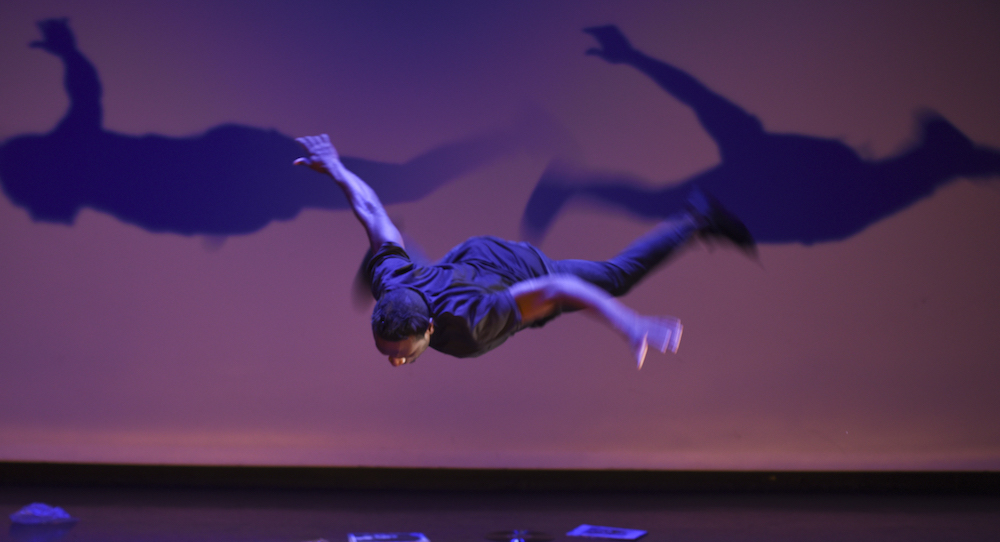Riverside Theatres Parramatta.
7 June 2019.
Two thought-provoking solos in the latest work presented by FORM Dance Projects at Riverside Theatres Parramatta under the umbrella title, Passing It On.
First was How I Practice My Religion by Ryuichi Fujimura. Fujimura is a Sydney-based dance artist originally from Japan. In this solo, he traces his personal dance history and acknowledges what is stored in his dancing body. The work is dedicated to his first three dance teachers – Margaret Lasica, Caroline English and Anastasi Siotas. It begins quite formally, in some ways a lecture with movement: Fujimura appears on stage in an elegant business suit introducing himself and drawing on a white board with coloured markers. At first, the drawing is like the outline of a house, then becomes a church (the body as a temple, dance as a religion?) and eventually becomes a vibrant, colourful dancing body.

Ryuichi Fujimura’s ‘How I Practice My Religion’. Photo by Heidrun Lohr.
Fujimura is at first formally dressed but strips down to bare feet with singlet and shorts. At first, he just stands there dramatically lit, then various isolation movements are performed and his arms stretch stretch stretch, then become rippling around his body. This then becomes as if Fujimura is floating, which changes to swooping, coiled movements. A various range of dance styles are presented, with Fujimura talking about his dance teachers and also his family life. Backward runs, side to side skips, falling, rolling, slithery crawls, flat-footed galloping and more are all demonstrated and announced (perhaps defined). Whirling, windmill arms are contrasted with straight, angular movements. A showbizzy segment follows with a glitzy gold hat in the style of A Chorus Line. This is then changed to slo-mo movements almost Butoh-like, culminating in a slow fall and roll. Fujimura then suddenly darts and “breaks the fourth wall”, running in to the audience briefly. An abstract solo with a chair follows, “exploring the relationship with another person,” which leads to various poses. He also talks about muscle memory being entrenched in the body. There are more drawings on the whiteboard and ….. eventually fade to black.
The second half of the programme was Full Circle by Sydney-based dancer and choreographer, Lucky Lartey. The work is based on hip hop culture and West African storytelling traditions and includes screen footage of infectious West African drumming. We follow Lartey on his personal journey of discovery of the links between the two, going full circle. It is also influenced by the West African storytelling tradition and how this was used to pass on knowledge. He talks a little about his life, and we see photos on screen of him at various points in his life.

Lucky Lartey’s ‘Full Circle’. Photo by Heidrun Lohr.
For most of the work, Lartey wears a torn white t-shirt with a colourful logo and white trousers. Lartey is incredibly fluid, flexible and energetic. His moves include headstands, wild runs, dizzying turns and leaps, acrobatic backbends, angular hops on one leg, as well as snaky, quivering arms. There is also an anguished, trapped, twisted, sculptural-like section.
Lartey’s West African heritage is acknowledged with his bringing on a special beaded bag which contains a coffee/teapot and three cups- a ritual offering of respect. The work also uses voiceover, of an interview, about his community involvement, which also asks the question, Are you an artist or an activist?
Much effective use is made of a circle of light centre stage at one point and shadows and silhouettes.
For the final part of the work, Lartey enters in blue jeans and a dark t-shirt, carrying a load of programmes, CDs, DVDs and videos, which he spreads in a circle then dances around. Breakdance/hip hop moves are elegantly exuberantly performed. Then Lartey enters carrying a huge boom box, sits on the boom box and drinks.
By Lynne Lancaster of Dance Informa.













